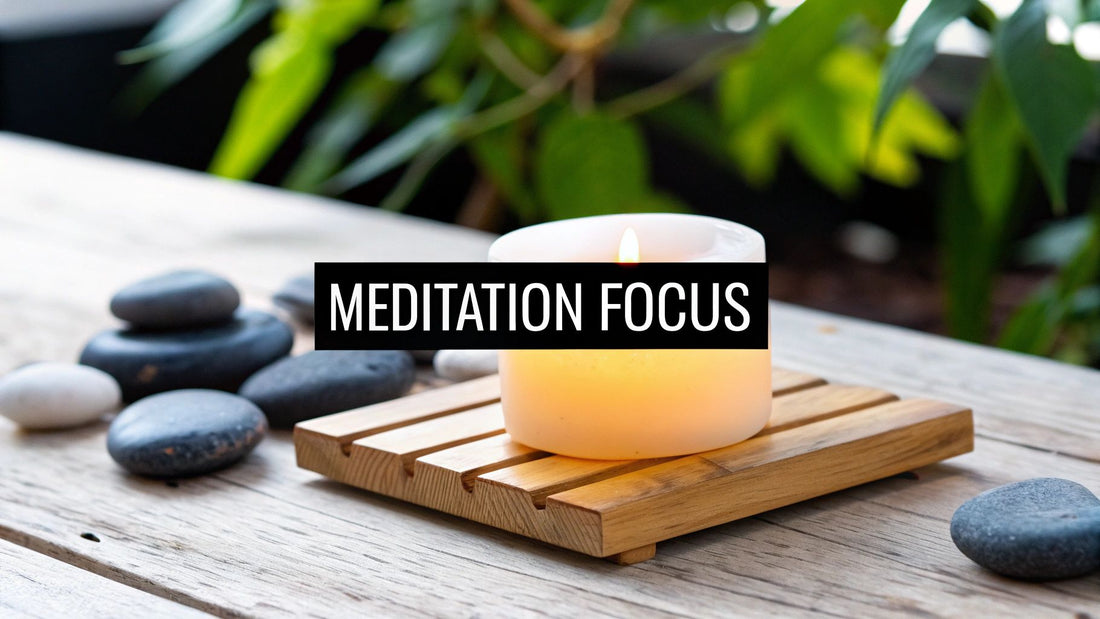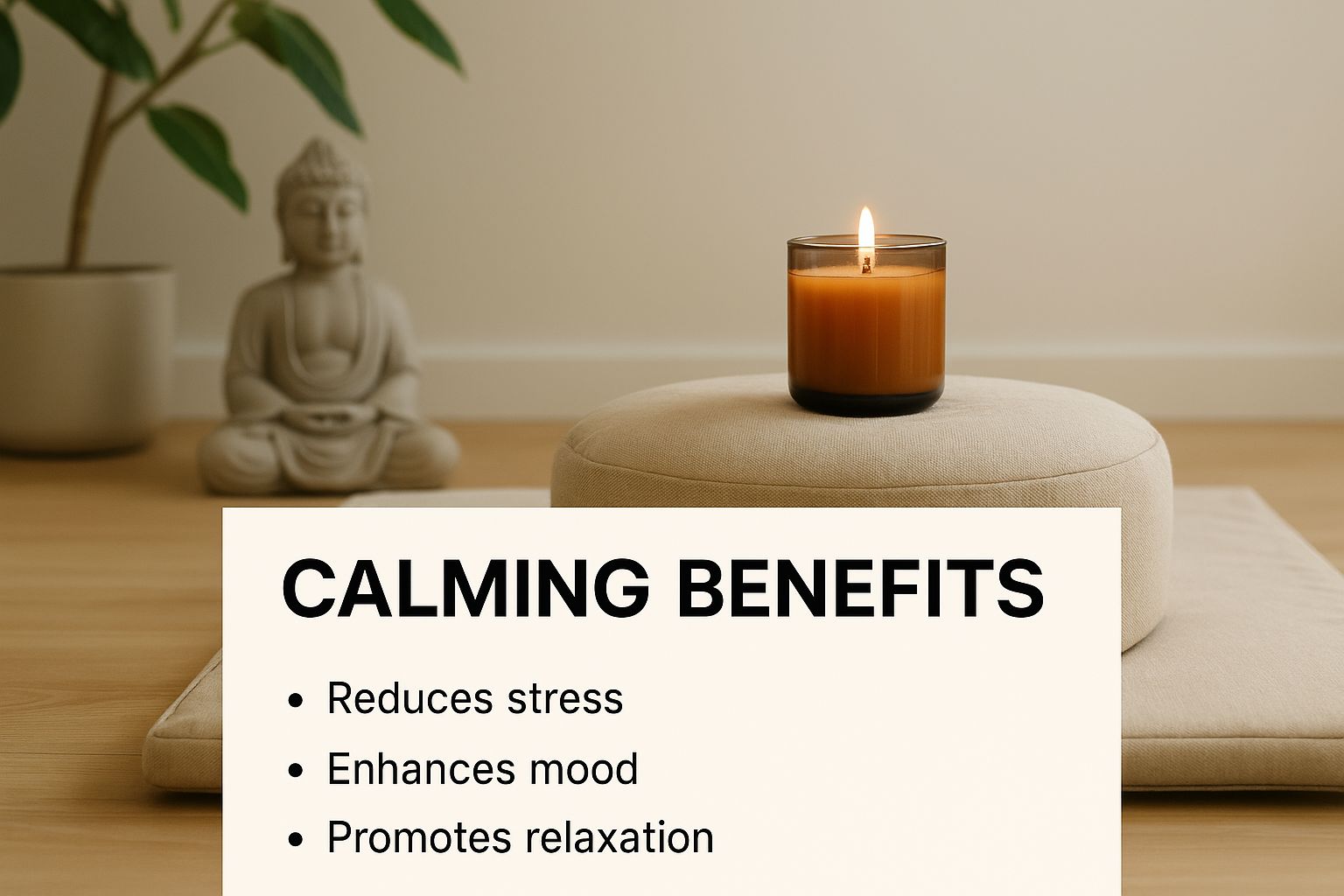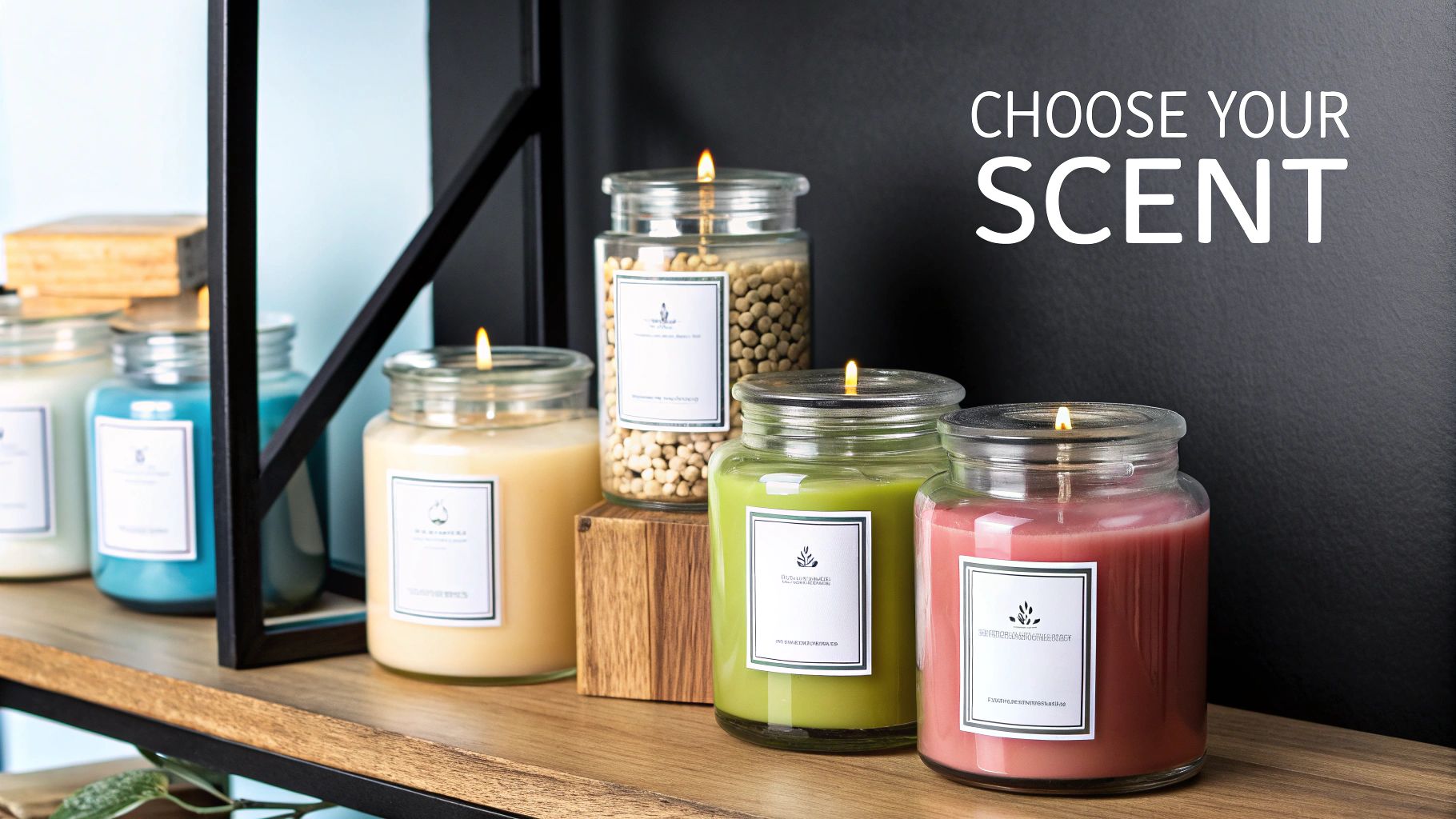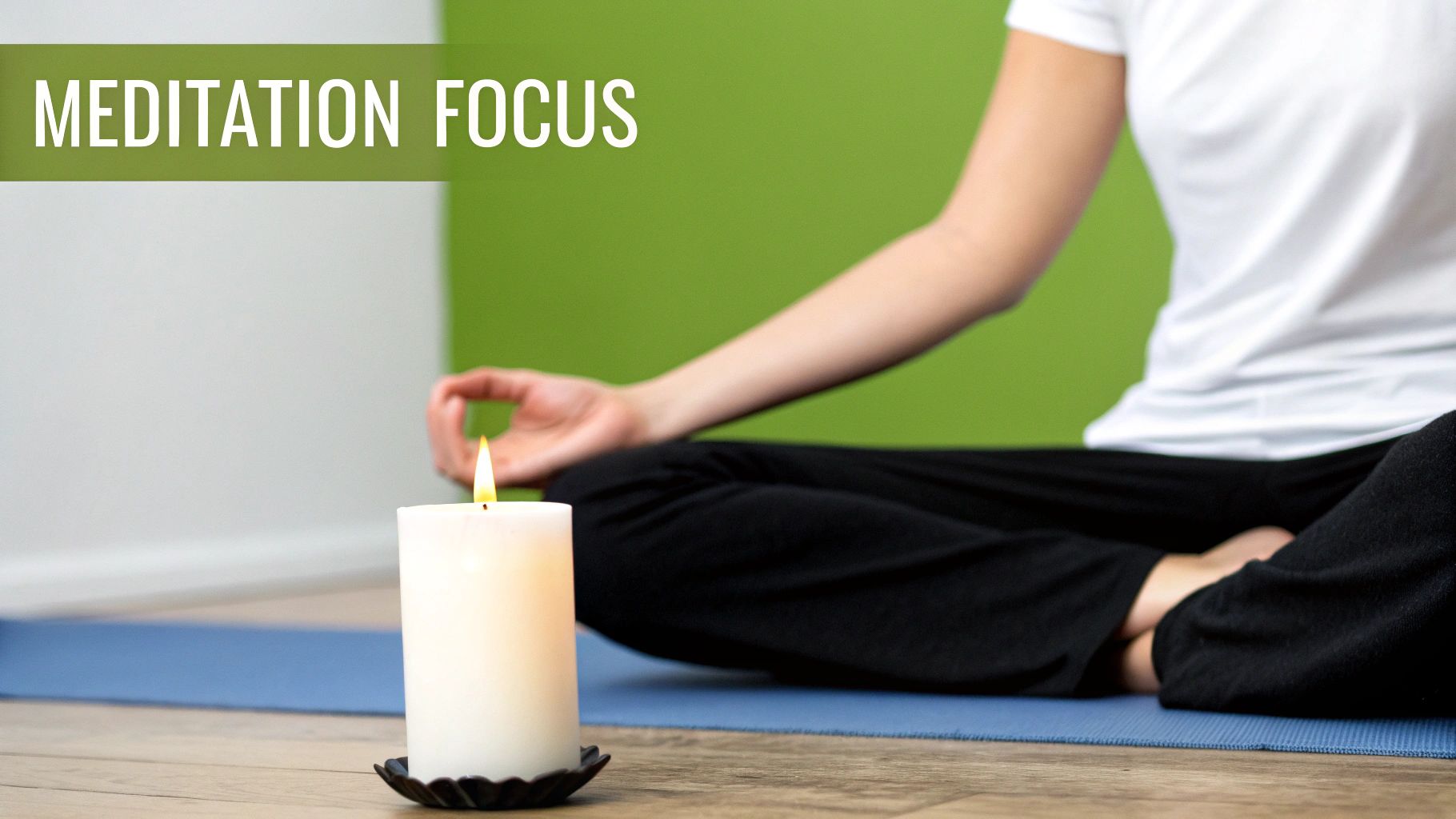
Aromatherapy Candles for Meditation Your Guide to Focus
Aromatherapy candles are a wonderfully simple, yet surprisingly effective, way to deepen your meditation practice. They work by combining the soft, hypnotic flicker of a flame with specific scents designed to calm the mind, helping you build a sanctuary for your practice. Think of the candle as a sensory anchor—a gentle signal that helps quiet the constant mental chatter and brings you fully into the present moment.
How Scent Transforms Your Meditation Practice
Have you ever caught a whiff of rain on hot pavement or the smell of a particular flower and been instantly transported back to a vivid memory? That’s your olfactory system at work. Our sense of smell has a direct line to the brain's emotional and memory centres, which is exactly why using aromatherapy candles for meditation is so powerful. It's not just about enjoying a pleasant fragrance; it’s about intentionally steering your mental state.
When you light a candle, its aroma is like a key unlocking a specific mood. The scent molecules travel straight to the limbic system, the part of your brain that handles emotions, memories, and even basic functions like your breathing rate. This biological shortcut is what allows certain smells to shift your mindset almost instantly, creating the perfect headspace for mindfulness.
It's a well-known phenomenon in wellness circles. For instance, a recent study highlighted that scents like lavender and sandalwood have a measurable calming effect on the limbic system, which can significantly reduce feelings of anxiety. It's not surprising, then, that approximately 62% of Californian wellness consumers say they use scented candles during meditation or yoga to help them de-stress and find mental clarity. If you're curious about the deeper connections, you can learn more about how scents influence wellness practices from this research.
The Science of Scent and Stillness
The link between a beautiful scent and a quiet mind isn't just a nice idea; it's rooted in our physiology. As you breathe in the essential oils released from a candle, you’re setting off a subtle but powerful chain reaction in your body.
The fragrance becomes a gentle, persistent reminder for your brain: it’s time to slow down. Time to let go of distractions. Time to turn your attention inward. With repetition, this grows into a powerful ritual, making it easier and quicker to drop into a meditative state each time you practice.
This process helps guide you out of that state of busy, scattered thinking and into one of focused awareness. The candle’s scent becomes a reliable cue in your routine, signalling to both your body and mind that a period of peace and reflection is about to begin.
To make it even clearer, let's look at how different scents can support your meditation.
Core Benefits of Aromatherapy Candles in Meditation
The table below breaks down the key advantages of bringing scented candles into your meditation space, showing how specific aromas can enhance your experience.
| Benefit | How It Enhances Meditation | Example Scent |
|---|---|---|
| Deeper Relaxation | Calming scents soothe the nervous system, helping release physical and mental tension. | Lavender |
| Improved Focus | Certain aromas clear mental fog and help anchor your awareness to the present moment. | Sandalwood |
| Mood Elevation | Uplifting fragrances can create a positive and energised mindset for your practice. | Bergamot |
Ultimately, by choosing your aromatherapy candles for meditation with intention, you’re not just buying a candle—you're selecting a specific tool to support your goal, whether that’s finding calm, sharpening your focus, or simply cultivating a moment of inner peace.
Finding the Right Scent for Your Mindful State
Choosing a fragrance for your meditation practice is about so much more than just picking a scent you like. It’s about being intentional. Think of it like creating a playlist for a specific mood—you wouldn't put on high-energy dance music when you're trying to unwind. The right aroma can support your meditation, while the wrong one can be a distraction.
Once you understand how different scent families work, you can build a personal ‘scent toolkit’ to help guide your mind exactly where you want it to go. We can break down the most effective scents into three main groups, each suited for a different mental state: grounding, calming, and uplifting.
Grounding Scents for Stability and Presence
When your mind is racing and you feel untethered, grounding scents are your anchor. These are the deep, earthy, and resinous fragrances that connect you to the present moment and create a powerful sense of stability. Think of rich, woody notes like sandalwood, cedarwood, and frankincense.
Imagine trying to meditate when you feel scattered and all over the place. A grounding aroma acts like a steadying hand, gently pulling your awareness away from distracting thoughts and rooting it firmly in your physical space. It’s the perfect choice for those days when you feel particularly restless or you simply need to build a solid foundation before going deeper into your practice.
Calming Scents for Peace and Relaxation
If your main goal is to release tension and soothe a worried mind, calming scents are your best friends. These are typically soft, gentle, and floral aromas known for their profoundly relaxing effects. Lavender and chamomile are the classics here, and for good reason—they're famous for their ability to quiet the nervous system.
These scents essentially send a signal to your brain that it’s safe to let go and unwind. They can help slow a racing heart, encourage deeper, more rhythmic breathing, and wrap you in an atmosphere of pure tranquility. This makes it so much easier to release the day’s stress and sink into a truly peaceful state.
The right scent can completely transform your space, turning it into a sanctuary for a more centered mind.

As you can see, a serene environment, enhanced by the perfect candle, is a key ingredient for finding that inner calm.
Uplifting Scents for Energy and Focus
Sometimes, meditation isn’t about winding down at all. It’s about sharpening your focus, clearing out the cobwebs, and cultivating positive energy. For those sessions, you’ll want an uplifting scent. These are your bright, crisp, and often citrusy fragrances like bergamot, lemon, and invigorating eucalyptus.
Think of these vibrant scents as a cool breeze on a stuffy day—they cut right through mental fog and sluggishness. They’re fantastic for morning meditations when you want to start the day with clarity and drive, or for any practice where the focus is on generating joy and alertness.
By making a conscious choice from these scent families, your candle becomes more than just a lovely accessory. It becomes a powerful tool for intentionally shaping your state of mind. If you’re curious about how the candle's material itself plays a role, you can learn more about using soy candles for meditation and yoga and how natural waxes can elevate the entire experience.
What to Look for in a High-Quality Meditation Candle

When you're searching for the right aromatherapy candle for meditation, it's easy to get drawn in by beautiful packaging or a tempting scent. But not all candles are made the same, and the real difference between a truly helpful candle and a generic one comes down to its core ingredients and how it's made. To protect your air quality and actually experience the therapeutic benefits, it's crucial to look beyond the surface.
Think of it like this: you wouldn't put low-grade fuel in a high-performance car and expect it to run well. In the same way, you shouldn't fill your sacred meditation space with fumes from a low-quality candle. The first and most critical component to check is the wax.
Choosing the Right Candle Wax
The wax is the very foundation of your candle. Many of the candles you’ll find on supermarket shelves are made from paraffin wax, which is a cheap byproduct of refining petroleum. When you burn paraffin, it can release things like toluene and benzene—volatile organic compounds (VOCs) that you definitely don't want to be breathing in while you’re focusing on deep, mindful breaths.
For a much cleaner and healthier burn, always reach for natural waxes.
- Soy Wax: There's a good reason this plant-based wax is so popular. It burns cleanly and at a slower pace, meaning your candle not only lasts longer but also releases its scent more gently and consistently.
- Beeswax: This is another brilliant natural choice. Beeswax gives off its own subtle, comforting honey aroma and is even thought to help purify the air as it burns.
- Coconut Wax: Praised for its incredible scent throw and clean burn, coconut wax is often blended with soy to create a candle that performs beautifully and is sustainably sourced.
Natural waxes aren't just a better choice for your health; they're also kinder to the planet since they come from renewable resources. To learn more, you can explore the beauty of natural soy wax and its unique benefits in our detailed guide.
The Power of Pure Essential Oils
The "aromatherapy" in your candle is only as good as its source. A high-quality candle will be made with 100% pure essential oils that are distilled directly from plants. These are what carry the true therapeutic properties—the genuine calming effect of lavender or the grounding essence of cedarwood.
On the flip side, many mass-produced candles use synthetic "fragrance oils." These are scents created in a lab to mimic natural smells. While they might be pleasant, they offer none of the wellness benefits and can contain phthalates and other harsh chemicals you don’t want to inhale, especially during your practice.
Your sense of smell is wired directly to the limbic system—your brain's emotional centre. Using pure essential oils ensures you’re activating this connection in a positive way, helping to genuinely guide your mind toward a state of calm and focus.
This growing awareness is reflected in the market. Trends show that California's aromatherapy candle market is growing by over 12% annually. A significant 48% of consumers there now prefer sustainable, eco-friendly candles, and they are willing to pay more for hand-poured soy blends made with pure essential oils. This shift shows a clear demand for quality and authenticity in the products we bring into our wellness routines.
Integrating Candles into Your Meditation Ritual

An aromatherapy candle can be so much more than just a nice-smelling light source. When you bring it into your meditation practice with real intention, it stops being just another object in the room and becomes a powerful tool for mindfulness. The secret is building a small, consistent ritual around it.
This whole process can start with the simple act of striking a match. That small sound and motion can be a powerful signal to your mind and body, telling them it's time to shift gears—to move from the chaos of the day into a dedicated moment of stillness. Let the lighting of the wick mark the official beginning of your session, a deliberate step into your personal sanctuary.
Using the Flame as a Focal Point
One of the most potent ways to use your candle is through a practice called trataka, or candle gazing. It’s wonderfully simple: you just use the soft, flickering flame as a single point of focus. By gently resting your gaze on the flame, you give your mind a specific job, which is a fantastic way to quiet that relentless inner chatter.
The flame’s gentle, unpredictable dance is almost hypnotic. It’s just interesting enough to hold your attention without being so stimulating that it pulls you out of a relaxed state. Think of it as a visual anchor that keeps you present and centred.
Want to give it a try?
- Find a comfortable seated position with a straight spine, placing the candle about an arm's length away from you.
- Soften your gaze and look at the flame without straining. Try not to blink for as long as feels comfortable.
- When your eyes naturally start to water, gently close them. You’ll likely see an afterimage of the flame behind your eyelids—just observe it.
- Once that image fades away, you can gently open your eyes and start again.
This practice is brilliant for sharpening your concentration, but it also deepens the connection between your inner state and your outer environment.
The Aroma as an Anchor
Just as the flame anchors your sense of sight, the aroma from your candle anchors your sense of smell. Let's be honest, your mind is going to wander during meditation. It’s what minds do. When you catch your thoughts drifting off, you can gently guide your awareness back to the scent filling the room. This aromatic cue becomes a gentle, non-judgemental reminder to come back to right now.
And this isn't just a nice idea; it really works. Wellness retailers have noticed that adding aromatherapy candles to meditation sessions is linked to a 30% improvement in a person's ability to stay mindful. In fact, a 2023 study showed that 78% of practitioners who used candles with scents like sandalwood and white sage reported feeling more relaxed than those who didn’t. You can learn more about the influence of specific scents and how they affect our state of mind.
By weaving these sensory elements into your practice, your aromatherapy candle truly becomes a cornerstone of your meditation ritual.
Designing Your Ideal Meditation Space
While a great aromatherapy candle is the heart of your meditation, the space around it can make or break the experience. Think of it this way: the right environment can amplify your candle's calming effects, while a cluttered or distracting one can water them down. Creating a dedicated sanctuary—even if it's just a quiet corner—sends a powerful signal to your brain that it's time to slow down and turn inward.
You’re essentially building a nest for your mind. Your aromatherapy candle provides the central warmth and fragrance, but the other elements you choose can make that nest feel much more secure and inviting. The real goal is to create sensory harmony, where everything you see, hear, smell, and touch works together to guide you toward tranquility.
This means being mindful of what else you bring into your sacred space. The soft flicker of the candle should be your main light source, so it helps to dim or switch off any harsh overhead lights. Try introducing things that feel good to the touch, like a plush cushion, a soft blanket, or the smooth feel of a yoga mat. These simple tactile sensations help ground you in your body and anchor you in the present moment.
Principles of Sensory Harmony
To design a space that truly works, focus on engaging your senses in a gentle, intentional way. You don't need a lot; in fact, simplicity is usually more effective. A clutter-free space helps cultivate a clutter-free mind.
Here are a few simple ideas that can work in any home:
- Soothing Sounds: If total silence isn't your thing, complement it with soft, ambient sounds. This could be a small tabletop fountain, a playlist of gentle instrumental music, or even the quiet hum of your house settling.
- Natural Textures: Bringing in natural materials can be incredibly grounding. A simple wool blanket, a linen cushion, or a small potted plant can add an organic texture that connects you to the world outside.
- A Minimalist Approach: Keep your space free of distractions. This means removing anything that pulls your mind toward work, chores, or stress. This little corner should have one job: supporting your peace.
Your meditation spot becomes a physical anchor for your commitment to inner calm. By returning to the same thoughtfully arranged space each day, you build a powerful psychological trigger that helps you slip into a meditative state more easily.
Consistency is everything. A well-designed space, centred around the simple ritual of lighting your candle, transforms your practice from just another task into a deeply immersive experience. It's also important that your candle supports a pure environment—you can learn more about finding the right clean burning candles to keep the air quality in your sanctuary pristine.
Your Questions About Meditation Candles, Answered
It's completely normal to have a few questions before diving into a new wellness practice. When you’re bringing something like an aromatherapy candle into your meditation space, you want to feel confident you're doing it right—both for safety and for getting the most out of it.
This section is all about clearing up those common "how-to" and "what-if" thoughts. We’ll cover the practical side of things, from timing to safety, so you can stop wondering and start relaxing. Think of this as your final checklist before you light the wick and settle into your moment of calm.
How Long Should I Burn the Candle Before I Meditate?
For the best results, you’ll want to light your candle about 15 to 20 minutes before you actually sit down to meditate. This gives the flame enough time to melt the wax into a wide enough pool to release the full, rich aroma.
Think of it like preheating an oven. You’re giving your space a head start, allowing the scent to properly fill the room and create that perfect atmosphere. This little bit of prep work also sends a signal to your brain that it’s time to wind down, making the shift into a meditative state feel smoother and more natural.
Are These Candles Safe to Use Every Day?
Yes, absolutely! As long as you're choosing high-quality candles and using them mindfully, they are perfectly safe for a daily meditation ritual. The real key here is being a conscious consumer.
Stick to candles made from natural waxes like soy, beeswax, or coconut wax. Just as importantly, make sure they get their scent from pure essential oils, not synthetic fragrances that can contain unknown chemicals.
Of course, safety is always number one. A few simple habits will keep your practice peaceful and worry-free:
- Find a Safe Spot: Always place your candle on a stable, heat-resistant surface. Keep it well away from anything flammable, like curtains, books, or blankets.
- Let the Air Flow: A well-ventilated room is a must. This ensures fresh air can circulate, preventing the scent from becoming overwhelming.
- Trim That Wick: Before you light it each time, trim the wick to about a quarter of an inch. A shorter wick means a smaller, cleaner flame, which prevents that annoying black soot from forming.
- Never Walk Away: This is the golden rule. Never, ever leave a burning candle unattended. Be sure to extinguish it completely when your meditation is over.
Following these simple guidelines means your daily ritual will be a source of calm, not concern.
Can I Use Different Scents for Different Kinds of Meditations?
Not only can you, but you absolutely should! Matching your candle's scent to the intention of your meditation is one of the best ways to deepen your practice. It’s a lot like creating a playlist for a certain mood—the right aroma can instantly set the tone for your session.
Think of it as building a 'scent wardrobe.' You become the architect of your own experience, intentionally choosing the right tool to shape your mindset and make each meditation more focused.
Here are a few ideas to get you started:
- For a morning meditation focused on energy and focus, try a bright citrus or a crisp eucalyptus.
- Winding down in the evening? A calming lavender or soothing chamomile is perfect for releasing the day's stress.
- When you need to feel more grounded and centred, an earthy sandalwood or cedarwood can work wonders.
This simple act of choosing a scent turns your candle from a nice accessory into a powerful, active tool for your mindfulness practice.
How Is a Candle Different From an Oil Diffuser?
While both are great for scenting a room, a candle offers a uniquely immersive experience that many people find more grounding for meditation. A diffuser is wonderful for creating ambient fragrance, but a candle engages more than just your nose.
That soft, flickering flame provides a gentle, captivating focal point—a practice known as trataka, or candle gazing. It’s a visual anchor that can help quiet the mind in a way a diffuser simply can't. The combination of gentle light, subtle warmth, and enveloping scent creates a ritualistic atmosphere that feels ancient and sacred. There's a powerful intention behind the simple act of lighting a flame, connecting you to a long tradition of mindful practice and making the moment feel more complete.
Ready to create your own sanctuary? The hand-poured, natural soy wax candles from Shivora Candles are crafted with pure, non-toxic ingredients to perfectly complement your wellness rituals. Explore our collections and find the ideal scent for your next meditation session at ShivoraCandles.com.
